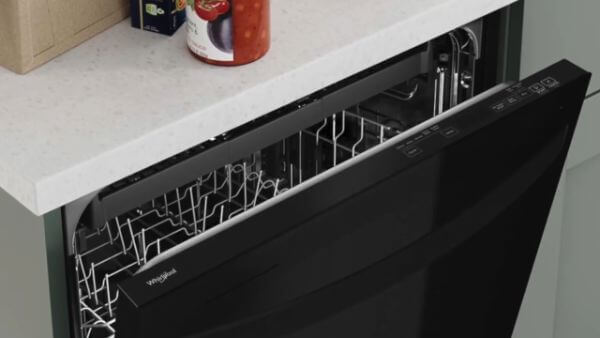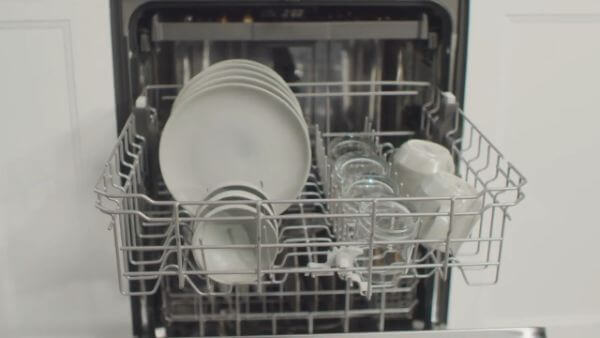Welcome to our dishwasher buying guide. Here you will find out how to buy a dishwasher, what to look for when buying a dishwasher.
Are you looking for a new dishwasher to help keep your kitchen clean, efficient and organized?
There is a wide array of dishwashers on the market so it’s important to do some research to find the one that’s best for your family’s lifestyle and kitchen design.
Here’s what you need to know.
Typically the main things to consider are size, style and features, including performance and noise level.
Table of Contents
Size
The first thing to consider is size.
Most built-in dishwashers are either 18 or 24 inches wide.
Bilt-in dishwashers are permanently installed under counters and between cabinets for a seamless look.
A 24-inch built-in dishwasher is a great choice for busy families or avid entertainers who go through a lot of dishes.
An 18-inch built-in is a space-saving condo friendly choice, perfect for smaller households and kitchens.
Built-in dishwashers aren’t your only option.
Other types of dishwashers include portable or countertop models.
Style
Like other major appliances, dishwashers can complement or enhance your kitchen design.
Wen it comes to style, most people start with the dishwasher exterior. After all that’s what you’ll notice every time you enter the kitchen.
Traditional dishwasher finishes include black, white and stainless steel. But today homeowners can choose from newer options, like low maintenance, fingerprint resistant stainless steel or sleek black stainless steel.
For a sophisticated upscale look, you could consider a panel-ready dishwasher. This type of dishwasher has an unfinished door that is designed to be covered with a custom panel matching your kitchen cabinetry.
Controls
Next think about the dishwasher controls. how visible do you want them.
Semi integrated or front control dishwashers. Put the control panel in plain view, flush with the dishwasher door. Exterior status lights display cycle progress.
By comparison, a fully integrated or top control dishwasher hides the control panel out of view. An exterior cycle indicator light provides feedback on each load.
Also consider the handle style. Would you prefer the streamlined look of a recessed or pocket handle. Or the convenience of a towel bar.
Interior Style
We talked a bit about exterior finishes. Now let’s look inside your dishwasher.
A dishwasher’s interior finish is more about performance than aesthetics.
Dishwasher interiors are typically constructed from plastic stainless steel or a hybrid of both.
Plastic tub dishwashers typically cost less but they can be noisier.
Stainless steel tubs are generally quieter, more stain resistant and can handle higher drying temperatures.
Interior Configuration
The interior configuration of a dishwasher can affect its capacity and how easily items are loaded.
Traditionally dishwashers only offered two racks with designated areas for flatware, cups, plates, pots and pans. But today’s dishwashers now offer more versatility to suit various lifestyles.
If you are a frequent home entertainer or have a growing family, prioritize adjustable or removable racks for flexibility that allow you to load large or odd-shaped items, such as platters, chargers or even blender jars and dishwasher safe water bottles.
Other features that help accommodate awkward items include fold down tines, which free up space for large pots and pans and stemware holders for securing wine glasses.
If you know the frustration of a crowded silverware basket, consider choosing a dishwasher equipped with a third level rack.
It provides an additional area for cutlery and longer cooking utensils, like chopsticks, spatulas and knives.
Some third level racks are even large enough to fit additional mugs and bowls.
Features
In addition to size and style, the other primary consideration in choosing a dishwasher is its features and performance.
Dishwasher features range from basic to advanced.
These features determine the appliance’s price, performance and its suitability for your family’s needs and lifestyle.
For example consider noise.
If you work from home, live in a small space or have young children, a dishwasher’s noise level can really impact your satisfaction with the appliance.
Dishwasher noise is calculated in decibel levels.
The higher the decibels, the noisier the dishwasher.
Dishwashers with noise ratings of 40 decibel levels or under may be virtually silent while in operation.
Meanwhile those with decibel ratings of 50 and up can produce a noise level similar to a normal conversation.
Next let’s take a look at performance. A dishwasher’s ability to get dirty dishes sparkling clean.
Basic dishwashers typically have two wash cycles.
Normal and light, which suit the most common needs of most households.
Depending on your household’s needs that may or may not be enough for you.
Many dishwashers offer additional cycles such as quick wash, rinse and hold, steam, delicate wash, heavy duty and sanitize.
Certain models may offer even more variety, including cycle options like ultra quick or less dirty items, or a heavy duty cycle geared specifically to pots and pans.
Some dishwashers may even offer the option to create a custom cycle. This allows you to cater to more delicate items like China or crystal, so they’re treated extra gently while coming out spotless.
Performance Features
Here are some more performance features to consider.
Dishwashers equipped with soil sensors also known as turbidity sensors monitor the level of tiny substance particles that might be present in the wash water.
This allows the dishwasher to recognize when dishes are heavily soiled and extend the cycle time accordingly.
This ensures optimal performance for every load.
Dishwashers equipped with heavy wash zones have a spray zone to attack heavily soiled dishes and oddly shaped items.
Features like flexible wash arms and bottle wash sprays allow for greater wash coverage.
Dishwashers that use filter based systems tend to minimize noise levels while optimizing water and energy conservation.
Most dishwashers offer the ability to delay the start of a cycle by two, four, six or eight hours after loading.
This allows you to run your dishwasher during off-peak energy hours or while you’re out of the house.
Now that we’ve talked about wash cycles, let’s not forget drying.
Drying is another factor in getting clean dishes and spotless glassware.
Dishwashers with stainless steel interiors retain heat from the wash cycle resulting in efficient drying.
Fan assisted drying accelerates drying performance by removing humid air from the appliance and replacing it with room temperature air. It’s a feature typically found on premium dishwashers.
By comparison, heat dry is a manual option that users can turn on or off. The default is typically on to ensure your dishes are dry and ready for putting away.
Filter Style
We’ve talked about the size, style and performance considerations that go into comparing dishwashers.
One last thing to consider is the filter style of a dishwasher.
Filters are what prevent food from falling back onto items during a cycle. Dishwashers usually either have a manual or self-cleaning filter.
Manual filters are a quieter option but they typically require that you regularly clean them out.
Many self-cleaning filter systems have a grinder that pulverizes debris so it can make its way out of the dishwasher. Other units use increased motor power to discard debris and keep the filters clean.
Installation
As we noted earlier, built-in dishwashers come in two standard widths 18 and 24 inches.
Iif you’re replacing an existing built-in dishwasher, the easiest approach is to simply buy the same size unit.
If you’re renovating your kitchen or if you’ve never had a built-in dishwasher before, you will need permanent plumbing installation to set up your new appliance.
You will also have to ensure that your home’s electrical output is sufficient for the location of a new dishwasher.
You will typically need a grounded electrical outlet, not an extension cord or adapter, and a dedicated 15 amp circuit.
Refer to the specific dishwasher use and care guide for additional installation requirements and guidelines.
Whether you are trading a new dishwasher for an old one or you’re redesigning a space from scratch, always hire a trained and certified technician to install your dishwasher.
The right dishwasher can really enhance your kitchen and your day-to-day enjoyment of your home.
Look for a model that meets your performance needs while complementing your kitchen’s overall aesthetic.
We hope you found this guide helpful as you plan your dishwasher purchase.




